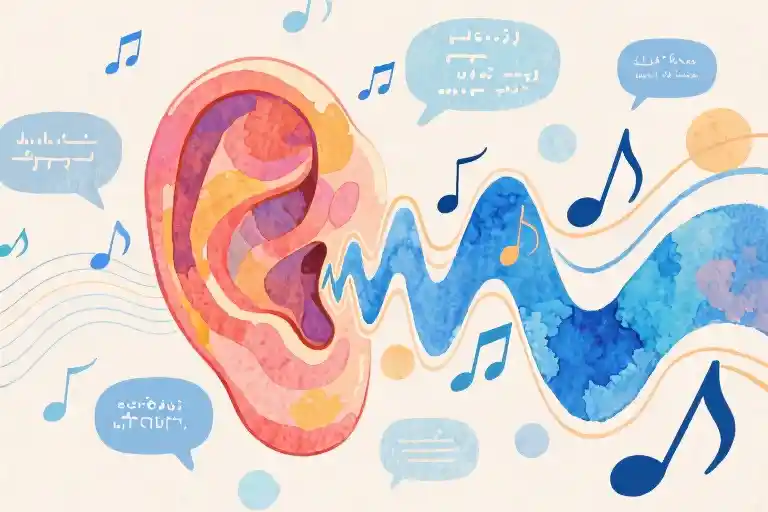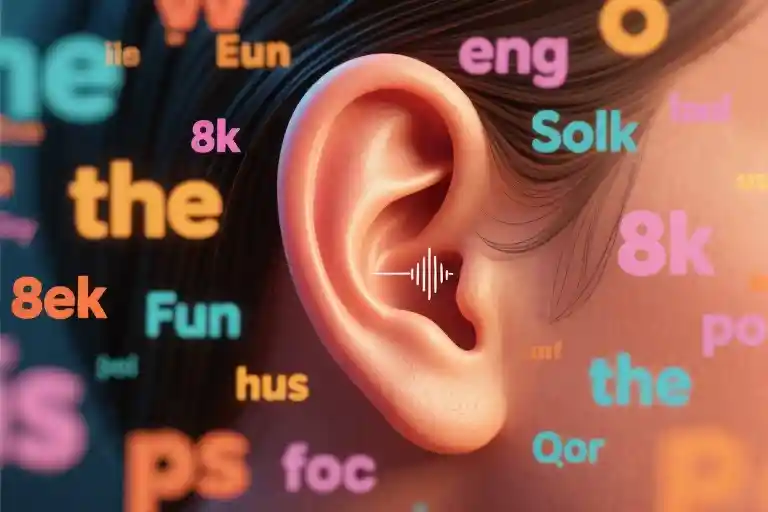The moment the audio clip ends, I can already predict what’s coming next. A collective sigh fills the classroom, followed by the inevitable chorus: “They were speaking so fast!” If I collected a coin for every time I’ve heard this exact complaint from language learners, I could probably retire tomorrow.
This frustration isn’t unfamiliar territory for me. Standing at the front of the classroom with my teacher’s hat on, I nod sympathetically. But secretly, I’m also wearing my student’s cap – the one that remembers all too well those early days of language learning when native speakers sounded like they were auctioneering in some alien tongue. The experience is universal: you lean forward, eyebrows knitted in concentration, mentally begging them to just… slow… down… while their words blur together into meaningless noise.
What most learners don’t realize is that speed, while certainly a factor, is just the tip of the listening comprehension iceberg. The real challenges lurking beneath the surface are far more complex – and far more conquerable – than simple velocity. As someone who’s navigated these waters from both sides, I’ve come to understand that what we perceive as “speaking too fast” is often a combination of several distinct linguistic phenomena.
Consider this: when you watch a tennis match, the ball appears as a continuous blur not just because it’s moving quickly, but because your eyes haven’t learned to anticipate its trajectory. Similarly, the difficulty in understanding rapid speech stems not merely from speed itself, but from our unfamiliarity with the patterns and shortcuts native speakers take for granted. These include the subtle dance of connected speech, where words blend together like colors on a wet canvas, and the rhythmic emphasis that gives sentences their musicality.
The good news? These aren’t insurmountable barriers, but learnable skills. Just as tennis players develop the ability to track that lightning-fast ball, language learners can train their ears to decode rapid speech. It begins with recognizing that what feels like an impossible flood of sound is actually a series of predictable patterns – once you know what to listen for.
What makes this realization particularly powerful is that it shifts the problem from being about the speaker (\”they’re too fast\”) to being about our own listening strategies. This subtle reframing opens doors to practical solutions rather than leaving us stuck in frustration. After all, we can’t control how native speakers talk, but we can absolutely develop techniques to understand them better.
The Three Stealth Killers of Listening Comprehension
Language learners often fixate on speed as the primary barrier to understanding native speakers, but the truth is far more nuanced. When students tell me “They’re just talking too fast!” after a listening exercise, I nod sympathetically while mentally noting the other culprits at play. Speed matters, but it’s rarely the sole villain in this story.
The Classroom vs. Reality Speed Gap
Consider this: most language learning materials deliver speech at 120-140 words per minute, carefully enunciated by voice actors. Then you step into the real world where English speakers average 180 wpm in casual conversation, Spanish rockets to 220-250 wpm, and French speakers seem to treat words like Olympic sprinters. This 30-40% speed differential creates what I call the “listening comprehension gap” – that frustrating space between what you’ve practiced and what you actually encounter.
But here’s what most learners miss: native speakers don’t just talk faster, they talk differently. The classroom teaches you to expect “Do. You. Want. To. Go. To. The. Movies?” while reality gives you “D’ya wanna gedda movies?” That brings us to the real challenges.
When Words Start Holding Hands
Connected speech phenomena transform careful pronunciation into a linguistic obstacle course. Take liaison in French where silent letters suddenly awaken (“vous avez” becomes “vou-z-ave”), or English’s tendency to mash auxiliary verbs beyond recognition (“I would have” → “I’d’ve”). These aren’t exceptions – they’re the rule in natural speech.
Three key phenomena trip up learners:
- Linking: Consonants attaching to vowels across word boundaries (“not_at_all”)
- Reduction: Stressed syllables swallowing neighboring sounds (“probably” → “probly”)
- Elision: Complete sound disappearances (“library” → “libry”)
I once had a student convinced Brits said “brewry” instead of “library” until we analyzed the phonetic disappearance of that first “a.”
The Anxiety Feedback Loop
Here’s the cruel irony: the more you struggle to understand, the less you actually hear. When your brain enters panic mode, it literally filters out unfamiliar sounds as “noise” rather than processing them as language. I’ve watched students’ comprehension plummet 40% during stressful listening tests compared to relaxed practice.
This explains why you might understand a TV show perfectly at home but draw blanks during a real conversation. It’s not your ears failing – it’s your fight-or-flight response hijacking your auditory processing. The good news? All three barriers can be overcome with targeted strategies we’ll explore next.
Remember: What feels like “they’re too fast” is usually a combination of speed, sound changes, and stress. Isolating which factor affects you most is the first step toward solutions.
The Accent-Pronunciation Trap: What You’re Really Hearing
Language learners often come to me with the same exasperated complaint: “They’re not pronouncing the words right!” But here’s the uncomfortable truth – nine times out of ten, the native speakers are pronouncing everything perfectly well. The real issue lies in our inability to distinguish between three crucial concepts: accent, pronunciation, and clarity.
The Trifecta of Listening Comprehension
Accent refers to the distinctive way speech sounds based on regional or social background. Think of how ‘water’ becomes “wa’er” in some British dialects or transforms into a drawn-out “wader” in certain American Southern accents. These variations don’t indicate incorrect speech – they’re simply linguistic fingerprints of origin.
Pronunciation, however, deals with producing sounds in a way that’s considered standard or intelligible. When someone says “nucular” instead of “nuclear,” that’s a pronunciation issue. The key difference? Accents are natural variations; pronunciation errors are deviations from the established system.
Then there’s clarity – the often-overlooked third factor. I’ve met learners who could perfectly imitate Received Pronunciation but remained incomprehensible because they mumbled or swallowed their words. Clear speech transcends accent; unclear speech frustrates listeners regardless of dialect.
Case Study: The Global English Spectrum
Consider these authentic examples:
- A Londoner might say: “I can’t be bothered with all that” (“I cahhn’t be bohh’d wiv awl tha'”)
- A New Yorker might state: “Forget about it” (“Fuhgeddaboudit”)
- An Australian could remark: “He’s going to the hospital” (“E’s goin’ ta th’ospit’l”)
All three are technically correct within their respective dialects, yet each presents unique challenges for learners. The British speaker uses glottal stops, the American employs heavy linking, and the Australian demonstrates vowel shifts – all perfectly normal features of native speech that get mislabeled as “bad pronunciation” by frustrated students.
Why This Distinction Matters
Misidentifying accents as pronunciation errors creates two dangerous pitfalls:
- Unrealistic Expectations: Learners waste energy trying to eliminate natural accent features that even native speakers possess
- Listening Blind Spots: Students dismiss authentic speech patterns as “wrong” instead of training their ears to recognize them
That Scottish speaker didn’t “mispronounce” the /r/ sound – they articulated it differently according to their accent. The French native didn’t “forget” to pronounce the /h/ in “herb” – they’re following standard American usage.
The Learner’s Dilemma
I recall my early days learning Spanish, convinced all Argentinians were “slurring” their words. Only later did I understand that the /ll/ sound genuinely transforms into a /sh/ in Rioplatense Spanish – it wasn’t careless speech but systematic variation. This realization changed everything; instead of fighting the accent, I learned to appreciate its musicality.
Practical Takeaways
- Reset Your Benchmark: Stop comparing every speaker to textbook audio. Real language has infinite variations
- Train Your Ear: Expose yourself deliberately to different accents through platforms like YouTube or language exchange apps
- Diagnose Before Judging: When you can’t understand someone, ask yourself: Is this an accent difference, a pronunciation error, or a clarity issue?
Tomorrow when you hear that fast-talking native speaker, instead of thinking “They’re doing it wrong,” try asking “What systematic patterns am I missing?” That mental shift alone will open new doors in your listening comprehension journey.
The 4-Step Listening Breakthrough Method
Language learners often ask me for a magic bullet to understand native speakers. While there’s no single solution, this systematic approach has helped hundreds of students transition from frustration to fluency. The key lies in progressive adaptation – we’re not just training ears, but rewiring brains to process natural speech patterns.
Phase 1: Slow Motion Decoding
Begin with artificially slowed audio (0.7x speed recommended) using tools like Audacity or YouTube’s playback controls. This isn’t about staying slow forever, but creating a scaffolded learning environment. Focus on:
- Identifying content words (nouns, verbs) that carry meaning
- Noticing how small function words (to, the) get reduced
- Mapping sounds to written forms you already know
I suggest starting with scripted content like TED Talks or language course dialogues before moving to authentic materials. The goal isn’t perfection, but building confidence in recognizing word boundaries.
Phase 2: Shadow Dancing
Once comfortable with slowed audio, introduce shadowing – that delayed echo effect when you repeat speech 0.5-1 second after hearing it. This technique:
- Forces real-time processing rather than over-analysis
- Trains your mouth to form unfamiliar sounds
- Develops muscle memory for natural rhythm and intonation
Begin with short 30-second clips. Don’t worry about meaning initially; focus on becoming a human parrot. The linguistic magic happens when your vocal apparatus learns to anticipate connected speech patterns.
Phase 3: Chunking the Stream
Native speakers don’t talk in separate words but in thought groups. Practice dividing audio into meaningful chunks using these markers:
- Brief pauses (often at commas)
- Pitch changes
- Slight lengthening of stressed syllables
Mark these divisions with / in transcripts. Soon you’ll stop hearing individual words and start perceiving complete ideas – the mental shift from “word-by-word translation” to true comprehension.
Phase 4: Predictive Listening
The final stage trains your brain to anticipate content. Try these exercises:
- Pause audio mid-sentence and predict the next 3-4 words
- Listen to conversations and guess responses before they occur
- Watch videos with subtitles, covering part of the screen
This activates the same prediction mechanisms native speakers use, reducing cognitive load. You’re not just hearing language – you’re participating in it.
Remember, these phases often overlap. You might shadow simple conversations while still doing slow analysis of complex content. The progression isn’t linear, but spiral – each cycle building greater automaticity. Start where you are, use what you have, and trust the process. Tomorrow’s effortless listening begins with today’s deliberate practice.
When Listening Feels Like Decoding Ancient Scrolls
Mari’s first language breakthrough came during an episode of Demon Slayer. For months, Japanese dialogue had sounded like a continuous stream of incomprehensible sounds—until one rainy Tuesday evening when Tanjiro’s words suddenly separated into distinct vocabulary she’d studied. “I literally fell off my chair,” she told me during our coaching session. “It wasn’t that they slowed down. My brain finally learned to process the speed.”
This mirrors Pierre’s experience with French numbers. The Parisian bakery cashier might as well have been reciting incantations when rattling off “vingt-et-un euros cinquante.” Through targeted listening drills focusing solely on number combinations, he progressed from panic-induced nodding to confidently repeating amounts within six weeks. The key wasn’t magical immersion, but systematic exposure to specific phonetic patterns.
What both cases reveal:
- The plateau illusion – Progress often happens in sudden leaps after prolonged practice, not gradual improvement. Mari’s “overnight” comprehension resulted from months of accumulated neural adaptation.
- Chunking strategy – Pierre didn’t tackle all French pronunciation at once. By isolating number phrases (a high-frequency pain point), he created mental hooks for broader comprehension.
- Emotional calibration – Both learners initially misinterpreted their struggle as personal failure rather than a normal phase. Recognizing this shifted their focus from frustration to problem-solving.
For those currently in the “ancient scroll” phase of listening comprehension: your breakthrough exists on the other side of consistent, targeted practice. Like deciphering any code, the chaos gradually reveals its patterns—often when you least expect it.
Wrapping Up: Your Action Plan for Better Listening
By now, you’ve probably realized that understanding native speakers isn’t just about raw speed – it’s about training your ears to decode the musicality of natural speech. The good news? With consistent practice, your brain will gradually adapt to these patterns until what once sounded like chaotic noise becomes clear communication.
Here are three simple actions you can take today to start making progress:
- The 5-Minute Shadowing Challenge
Find a short audio clip (30 seconds max) at slightly slower than natural speed. Play it once through, then immediately try repeating what you hear with a 1-second delay. Don’t worry about perfection – this exercise builds muscle memory for pronunciation and rhythm. - Accident Investigation
Recall your last ‘I didn’t understand anything’ moment. Was it a specific word that tripped you up? A particular speaker’s intonation? Identifying these micro-failures helps target your practice. Keep an ‘enemy list’ of problematic sounds or phrases. - Speed Dating with Accents
Pick one regional variation (say, Irish English or Mexican Spanish) and spend 15 minutes listening to authentic materials from that area. Notice how vowels stretch or consonants disappear differently than in ‘textbook’ speech.
I’m genuinely curious – which accent consistently gives you the most trouble? Is it the melodic rise-and-fall of Caribbean Spanish? The clipped precision of German? Share your nemesis in the comments below.
Next time, we’ll dissect one of the biggest secrets to understanding fast speech: how words morph when they’re strung together in conversation. Why does ‘did you’ become ‘didja’ and ‘I am going to’ shrink to ‘I’m gonna’? The answers might surprise you – and finally explain those mysterious gaps in your comprehension.





